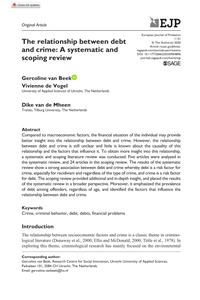Although the prevalence of cybercrime has increased rapidly, most victims do not report these offenses to the police. This is the first study that compares associations between victim characteristics and crime reporting behavior for traditional crimes versus cybercrimes. Data from four waves of a Dutch cross-sectional population survey are used (N = 97,186 victims). Results show that cybercrimes are among the least reported types of crime. Moreover, the determinants of crime reporting differ between traditional crimes and cybercrimes, between different types of cybercrime (that is, identity theft, consumer fraud, hacking), and between reporting cybercrimes to the police and to other organizations. Implications for future research and practice are discussed. doi: https://doi.org/10.1177/1477370818773610 This article is honored with the European Society of Criminology (ESC) Award for the “Best Article of the Year 2019”. Dit artikel is bekroond met de European Society of Criminology (ESC) Award for the “Best Article of the Year 2019”.
MULTIFILE

Compared to macroeconomic factors, the financial situation of the individual may provide better insight into the relationship between debt and crime. However, the relationship between debt and crime is still unclear and little is known about the causality of this relationship and the factors that influence it. To obtain more insight into this relationship, a systematic and scoping literature review was conducted. Five articles were analyzed in the systematic review, and 24 articles in the scoping review. The results of the systematic review show a strong association between debt and crime whereby debt is a risk factor for crime, especially for recidivism and regardless of the type of crime, and crime is a risk factor for debt. The scoping review provided additional and in-depth insight, and placed the results of the systematic review in a broader perspective. Moreover, it emphasized the prevalence of debt among offenders, regardless of age, and identified the factors that influence the relationship between debt and crime.
DOCUMENT

‘The fear of crime’ is “upon everybody’s tongue” nowadays (Farrall & Gadd 2004:1). The concept is widely accepted as social problem across the globe (Gray, Jackson & Farrall 2008, Garland 2001) as it is held to impinge ‘(…) upon the well-being of a large proportion of the population’ (Farralll et al. 1997:658). But do we actually have a valid picture of a genuine ‘social problem of striking dimensions’ (Ditton 1999:83)? Critical voices say we don’t. ‘The fear of crime’ - as we generally know it - is seen by them as ‘(…) a product of the way it has been researched rather than the way it is’ (Farrall et al. 1997:658). And still, 45 years after the start of research, ‘surprisingly little can be said conclusively about the fear of crime‘ (Ditton & Farrall 2000:xxi). This research contributes to a growing body of knowledge - from especially the last fifteen years - that treats ‘the fear of crime’ as ‘(…) a complex allocation of interacting feelings, perceptions, emotions, values and judgments on the personal as well as the societal level’ (Pleysier 2010:43). One often replicated and paradoxical observation catches the eye: citizens perceive a growing threat of crime to their society, but consequently perceive a low risk that they themselves will fall victim of crime. Taking a social psychological approach (e.g. see Farrall et al. 2000; Jackson 2008), we will search for suitable explanations for this paradoxical observation in the fear of crime’s research tradition. The aim of this research is ‘to integrate social psychological concepts related to the individual’s identity and evaluation of his position in an increasingly complex society, to enhance our understanding of the fear of crime concept’ (Pleysier & Cops 2016:3).
MULTIFILE
